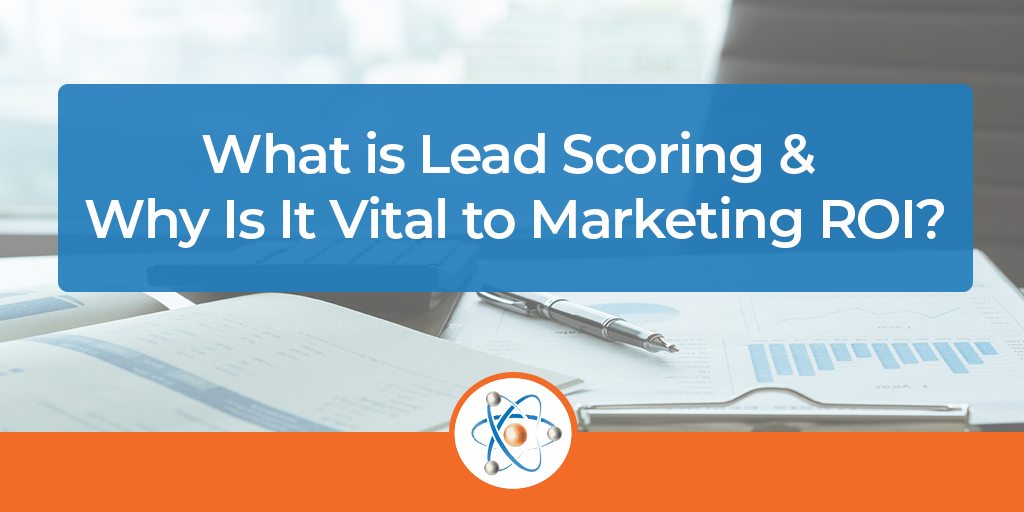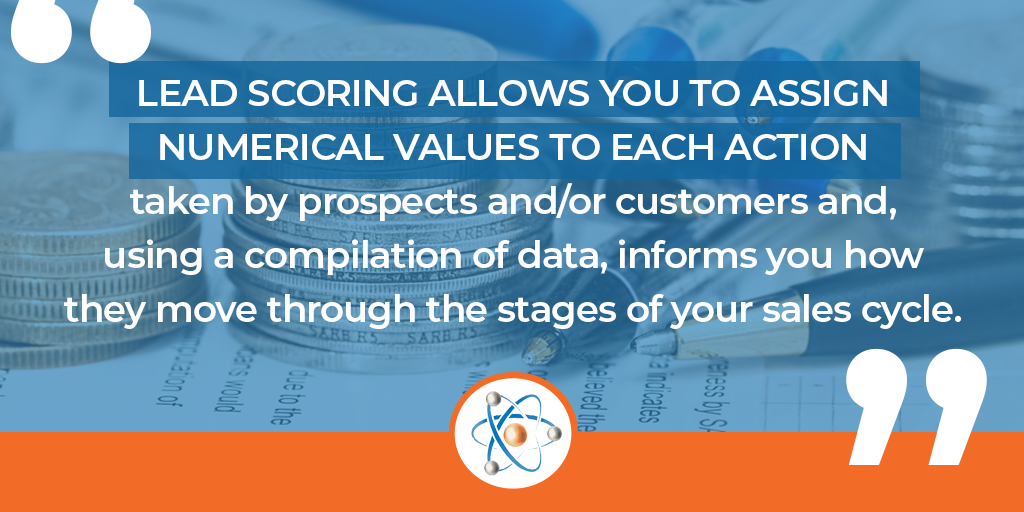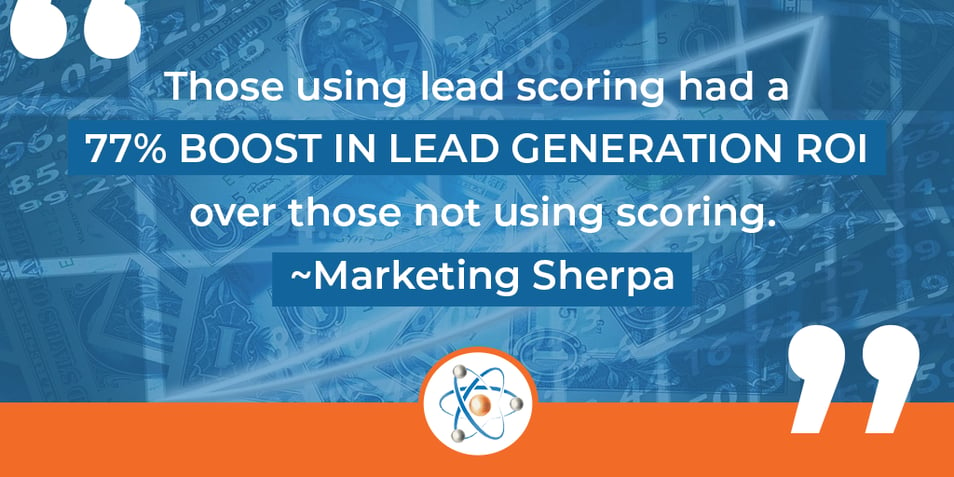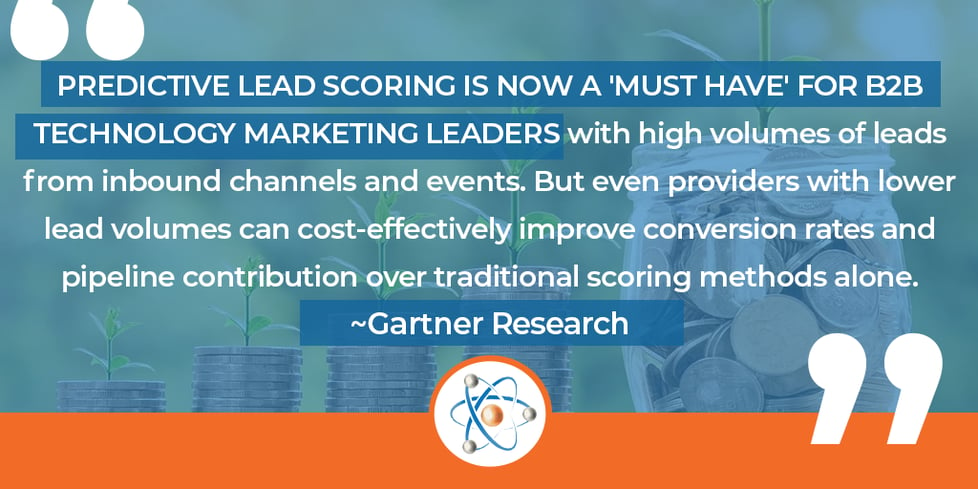
If you throw money at marketing activities assuming you know what your prospects and customers need or what is popular at the moment, you’re missing out on a sure-fire way to earn the ROI you desire and convert prospects into happy customers and customers into advocates. How? With Lead Scoring.
Lead Scoring is a form of measurement of prospects’ and customers’ activities that gives you total control of your marketing plan and lead generation activities. It provides structure that drives the actions you want targets to take and controls the outcomes. Lead Scoring helps you focus on marketing to qualified leads and nurturing future customer advocacy, making the most of every dollar spent.
Lead Scoring assigns different values to your targets’ actions and provides a quantifiable way to look at what people are thinking, so you can track their actions and interest level for calculated targeting.
Lead Scoring Measures Marketing Efforts
What if you could learn how many steps it takes prospects to convert and then speed up the process? How about anticipating customers’ needs and then proactively fulfilling them? Throwing money at random marketing tactics doesn’t pay – in the end, it’s costly and can even harm your reputation. It helps you measure your marketing efforts so you can convey the right message at the right time and create a relationship with those you’re targeting, without being a pest or swinging a wide net hoping to snag a few. Lead Scoring creates precision. The higher the lead score, the more qualified the lead, the higher the priority. It is 100% customizable to your company and objectives, but there is a general way in which the system works to provide the results you crave. Here is a synopsis of how it works.
It is nearly impossible to create an effective, revenue-generating lead generation, digital marketing, and customer retention strategy without assigning a system of measurement to the process and outcomes. How else can you plan, use your budget most effectively, and get the best ROI?
Assigning Values
Let’s say you have an active email campaign that goes to those who sign up to receive your news – some are prospects, some are customers. For each action a reader takes when they receive the email, you assign a score. For example, if they open it, it’s a “1.” If the stay and read, that’s a “10.” If they share it, you might assign 25 points to that action; if they click through to your website, 30 points, and when they finally fill out the contact form, that’s 50 points. For each activity, you increase in multiples by how much interest they show. Recipients might open your email three times (10 points each time) before they click through to the website (30 points), and then they jump off. Or they might share the email two times and go the website once and order…You can either use an aggregate to get to your threshold or pin that threshold number on one activity that gets them into the sales cycle. This is entirely up to you and your goals.
Next, create a strategy for those who get to that threshold – let’s say it’s 50 points. These people are now Marketing Qualified Leads (MQLs) – they’re ready to learn about your company. Target your marketing and attention accordingly to move them into the next phase of the buying cycle. You can then assign a score to the next several steps of communication to see how long it takes to close the sale.
On the flip side, if most of your email recipients never get past a score of 20, then you know you need to tweak the email. They’re opening it, so chances are the subject line is good, but what’s missing? After a few months of tweaking and monitoring, if very few people get passed 20, then it’s time to reassess your tactics. Email may not be the best way to reach your targets or customers. Without Lead Scoring, how else could you know this? You may have an email marketing platform that tracks some things for you, but most platforms can’t predict and hone what is happening or going to happen. They simply cannot provide the insight and targeted message delivery that Lead Scoring can provide and at the same time, work with all types of digital marketing, social media, and other forms of communication.

Hone Your Strategy Using the Data
The values have been assigned to certain activities, now what? The basic goal of all marketing is to grow sales and increase revenue. You can consistently increase revenue with predictability and lower your customer acquisition cost (CAC) by creating personalized experiences. These positive experiences convert prospects into customers who sing your praises to others and send referrals who do the same, which creates customer advocacy. Customer advocacy is the secret to steady growth rather than constantly trying to acquire new, possibly unqualified leads. Therefore, your marketing activities need to be carefully executed to reach your audience at just the right time (without hounding them), with the right message and helpful information, while making them feel like it’s all about them. This requires using the Lead Score data in your marketing automation campaigns to retarget and remarket with a steady, experienced hand.
Most people who reach a higher Lead Score are okay with steady communication and being remarketed if it’s done with care. They may even like the reminder. However, do not re-market someone who has visited your site once or has opened your email and done nothing else. This will annoy them and waste your dollars. If a person returns to your website several times or starts interacting with your social media pages, you have assigned values to these actions, so now you can move this individual along toward the sales funnel in a way that makes sense to them, nurtures them, and keeps them happy.

Where Do You Begin?
My recommendation is to start on a numbered scale from 1-100 in any increments you want – 2’s, 5’s, 10’s – whatever makes sense. Then, many months or even a year down the road, when you have a monsoon of data, you can break each score or action down even further into percentages. Once you start Lead Scoring, it should take several months, at least three, maybe closer to six, to have a feel for your scoring system, how your targets are behaving, and how to adjust your message. You need a reliable set of data before you make changes.
Many websites, email platforms, video demos, and pieces of digital media that you own typically have built-in lead scoring capabilities. It’s important to note, some platforms let you gather information BEFORE someone signs up on your site (ie: they visit but don’t fill out the contact form or sign up for your blog), and some do not track until a person fills out a contact form. No matter when you collect the data, you can score those who interact with all pieces of digital marketing and get really specific. You can add a value to interactions with your Chatbot, Google ad clicks, phone calls, and even track and score things like who purchased a $9.99 item versus a $20 item. It is up to you to create a scoring system for each activity and move people through your sales funnel to the thing you most want them to do. Keep in mind, it’s just as important to track and score customers’ actions as it is prospects’ behavior.
The life cycle of the buying cycle is constantly changing, which requires fine-tuning the scores, the massage, and the way in which you’re reaching people over and over until you hit the sweet spot for each goal. Once you get the system where you want it, the activities and scores come in as organized data, so eventually, you’ll have numbers, graphs, and/or charts for an at-a-glance idea of what is working well and what needs changing. Making adjustments brings more value to the process and maximizes marketing efforts. Lead Scoring will become critical to your business once you do it.
A Word About Tracking & GDPR Compliance
Everyone knows on some level that their online behavior is being tracked. Though most people don’t mind, it is ethically murky to track them unknowingly. That’s where the pop-up asking for permission to use cookies or track user behavior is a necessary evil. It is IMPERATIVE that your website and tracking process are General Data Protection Regulation (GDPR) compliant and people are told you are tracking them with the option to opt-out. Though GDPR is not an American law yet, it is a European Union (E.U.) law, so if your website can be seen by people in the E.U. (or people in the U.S. who are E.U. citizens), you should let them know you’re tracking them and give them the ability to opt-out.
Also, when a person fills out a contact form, even though there is “implied consent,” you still must give them the opt-out option. The good news here is that if someone is on your site with genuine interest, he or she will likely click the “allow” box and it gets forgotten. If they opt-out, all is not lost. They can revisit time and again and may eventually give that permission or even buy from you.
Not doing business overseas? This law (or one very similar) will likely be required in the United States very soon. If you’re in the design phase of a new website or considering updates, work it in now. Staying ahead of the curve may keep your website active while others are bogged down until they become compliant. GDPR is complicated and much harder to implement if you wait until you’re forced to do it.
Lead Scoring Improves ROI with Calculated Targeting
Lead scoring helps you target the right leads at the right time with the right message. You don’t have to guess anymore about how to turn prospects into MQLs and lower your CAC. When you understand the life cycle of leads and their needs at every stage, you drive the buying process and get prospects (and customers) through the process faster. You become their hero for anticipating and solving a problem they may not have known they had yet, and your sales will grow.
In this day and age, with so many in-your-face ads and too many emails, you want to become the resource who knows your prospects and customers and “gets them.” They will feel you care about them and share you with others, creating customer advocacy that is priceless. Lead scoring, when done with dedication, provides a higher marketing ROI. If you would like more information about Lead Scoring or would like professional help to implement a program, please reach out today and our experts at Atomic Revenue will be happy to help. 314.439.1280




